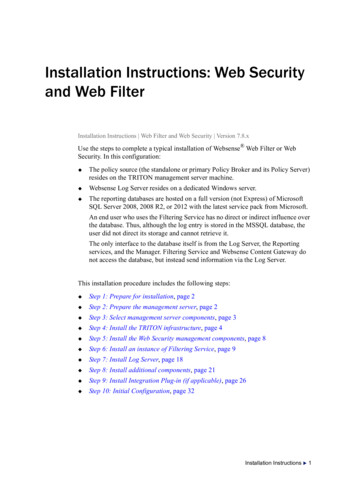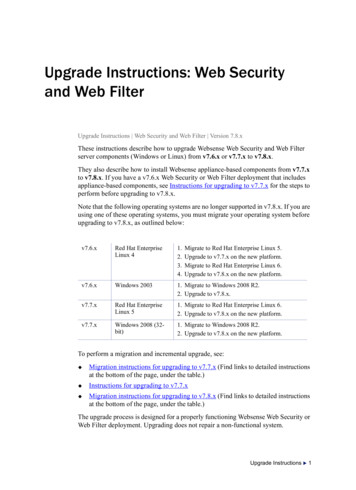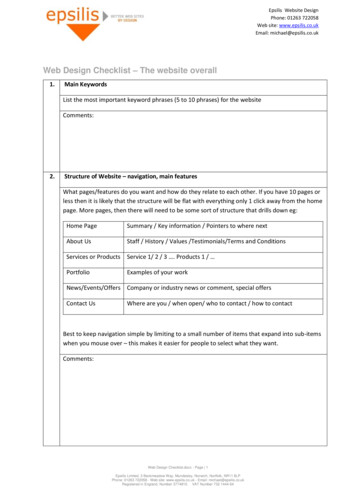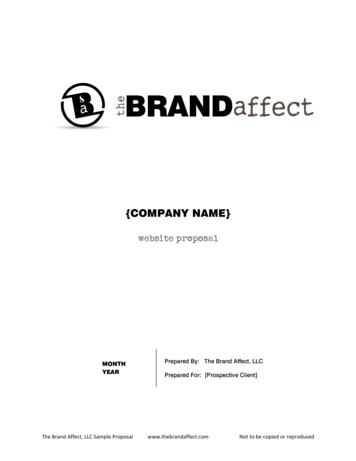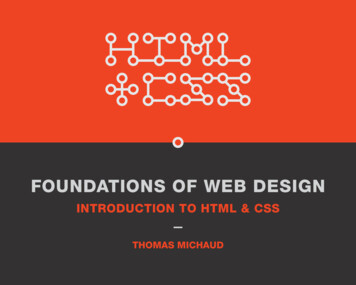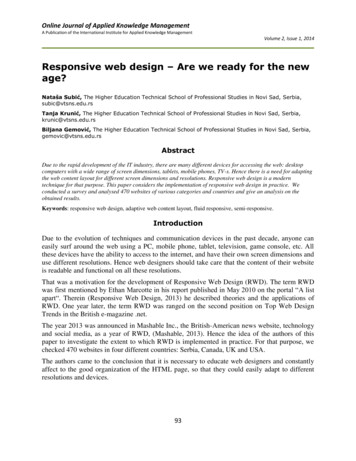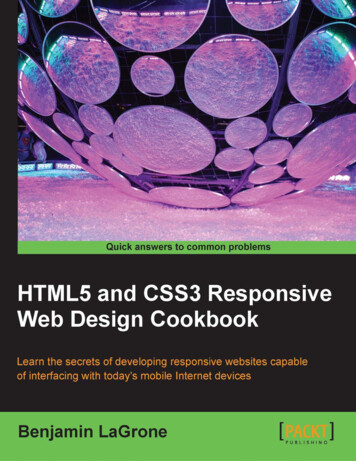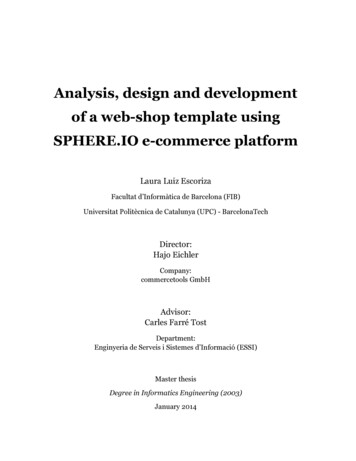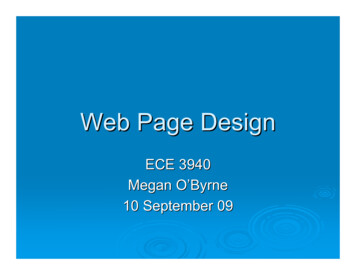
Transcription
UI Tipsfor Web Design EnthusiastsA Complete Guide toEditing and ModifyingYour Website
2Table of ContentsPAGE 3PAGE 4PAGE 4PAGE 6PAGE 6PAGE 6PAGE 8PAGE 8PAGE 9PAGE 10PAGE 11PAGE 12PAGE 13PAGE 15PAGE 16PAGE 17PAGE 18PAGE 19PAGE 19PAGE 20PAGE 21PAGE 22PAGE 23PAGE 24Intro: Design Meets BusinessUsing Colors to Your AdvantageColor PsychologyColor Matching ToolsIdentifying ColorsThe Ten Commandments of ColorsFinding the Right FontFont PsychologyIdentifying FontsThe Ten Commandments of TypographyFinding the Perfect Navigation StylePros and Cons of Hamburger MenusVertical Versus Horizontal NavigationOther Creative PatternsDesigning the Best LogoThe Psychology Behind a LogoFinding Free Logo TemplatesUI Design Tips and TricksSet ExpectationsFitts’ LawSimplicityFacilitation of Decision-MakingFinal WordsSources and Further Reading
3Intro: Design Meets BusinessHaving a website, whether it is for a business, an online store, or your own blog, can havemany benefits. Almost everything today is done online, and missing out on the opportunityto market yourself (or your business) on the internet is a big no-no.Not only is having an online presence important, but it is just as significant for that presenceto convey itself as professional and attractive. If it isn’t, your potential customers might notget past the front page and possibly miss all the amazing products, services, or contentthat you have to offer. With the use of color psychology, fonts, and logos, you can create anatmosphere that matches your content and attracts your target market.You can use these strategies to redesign certain elements of your website yourself. In thisbook, we will focus on some of the most important aspects of user interface design thatyou can take into consideration when modifying your website.
4Using Colors to Your AdvantageColors are just as important as your website layout or content. Colors add tone andemotion to your site. It’s the color scheme of a website that makes you instantly feelexcited, calm, intrigued, or even turned off (if the color combination is poor). Taking colorsinto consideration when modifying your website is crucial.Color PsychologyOne powerful aspect of your website’s user interface is the use of color psychology.Luckily, colors are something that you can tinker with.Colors have been used for years in marketing as a tool for attracting particular customerpersonas. This has been one of the most interesting, and sometimes controversial, formsof marketing. This is because marketers have seen color psychology work, but they arenot 100% sure as to why it works.Research has shown that color psychology may stem from our cultural upbringing. Itsays that we associate certain colors with different things in society. For example, red iswidely used by fast food restaurants in their logos because it is believed that red causeshunger in people.Regardless of your beliefs about this marketing strategy, it is certainly worth a shot. Theinfographic from The Logo Company summarizes the concept of color psychology. Youwill find a fragment of this infographic on the next page (along with a link to its fullversion
5Image credit: The Logo CompanyYou can also use the following infographics to determine the right color for your websitebased on your type of content: Orange is best used for sport, food, hotels, and travel websites. Check outthe infographic here. Purple seems to work best when used for beauty, fashion, finance, andbusiness websites. Red is best used for food, dating, cars, and design websites. Green is best used for agriculture, advertising, energy, and household websites.Image credit: MonsterPost
6Color Matching ToolsObviously, you will need more than one color to complete the design of a website. Otherwise,it will look awfully bland. So once you have a color in mind, create a palette around thatcolor.Image credit: CoolorsColor matching tools such as Coolors can help create amazing color schemes for yoursite. They can take the color of interest and create a palette that can be used for yourbackground colors, tables, fonts, borders, hyperlinks, and everything else.You will get a perfect color combination from your starting color, and take the guessworkout of the equation. This can save you plenty of time, especially if design is not yourstrongest skill.Check out other awesome tools for creating color schemes here.Identifying ColorsIf you’ve seen a color in a website, and you’d liketo have it on your own site, you can use a coloridentifying tool. One example of a color identifieris the Instant Eyedropper. Instant Eyedropper is ahandy tool that you can hover over any color,and it will identify it with a single click. It will determine the HTML color code of any pixeland you can use it directly in your browser.The Ten Commandments of ColorsOne last thing to mention in this section is the Ten Commandments of Color Matching.If you are just starting to understand color psychology and color schemes, follow the 10essential rules that you will find on the next page.
7Image credit: Designmantic
8Finding the Right FontJust like colors, fonts can give your website a feel of what it is about. Some fonts look funand friendly, while others look serious and professional. Using certain fonts on your sitewill convey different tones to your readers. Choosing the right one based on your contentis important.Font PsychologyImage credit: FreepikThere is a psychological aspect to fonts just like with colors. There are different feelingsand emotions associated with each, and choosing the right one can really make a differenceto your site. Today, font psychology is used in some of the biggest logos in the market.If you opt for a fancy font for your logo or name, make sure to use something simpler andreadable for the content. You want to convey a certain feeling using fonts, but you alsowant to make sure that the reader is able to easily read your content.
9Use this font psychology infographic to determine the tone you would like to bring in yourwebsite, and the font that matches that tone.Image credit: CrazyEggIdentifying FontsThere are several ways to identify an unknown font. You might need to do this if you’vefound a font online that you really like but can’t figure out which one it is. Instead ofspending hours trying to identify it on your own, try using a font identifying tool.One great tool for identifying fonts is What The Font.When working with What The Font, you submit an image of the font in question, and theirdatabase will match it to an existing font.
10Image credit: MyFontsOnce you’ve figured out what font you’d like to use, use TypeGenius to find the rightcombination of fonts for your page. This is one of the easiest ways to put together greattypography.The Ten Commandments of TypographyLast but not least, the ten commandments of fonts is something that needs to be mentioned.Just like in the case of colors, you can follow 10 simple rules to make sure that you get theperfect font for your web page.Image credit: DesignmanticDesignMantic created another great infographic for the 10 commandments of typography.Use these steps to avoid any hurdles while coming up with the best typography for yourwebsite. This is one tool you definitely should use when modifying fonts by yourself.
11Finding the Perfect Navigation StyleImagine that you walk into a grocery store for some breakfast cereal, but the store doesn’thave any signs above each aisle, and there are no store clerks to help you.You realize that you have to walk through each aisle to find what you are looking for. If youcan’t find the breakfast cereal after several minutes, it’s likely that you will leave and go toanother store (one with signs on their aisles).The same goes for any website.Regardless of what the content tells your readers, they will not be able to find it withoutproper navigation.Navigation is what allows your customers to find information easily, without the need of asearch bar. It also provides readers with an opportunity to discover new articles that theywould not have otherwise looked for. This can, in itself, be a great marketing tool.
12Pros and Cons of Hamburger MenusIf you don’t know what a hamburger menu is, it looks something like this:You’ve probably seen it somewhere. It is a popular tool that is widely used to save space andhide navigation menus. This type of navigation, as with everything else, has its advantagesand disadvantages.On the one hand, hamburger menus conveniently hide several UI elements behind a neat,easily-recognizable button. On the other, Nielsen Norman Group (a research firm that studiesinterfaces and usability) claims that hidden navigation may hurt the user experience.Given these two points, hamburger menus make a lot more sense when used for smallsmartphone screens only. Have a look at how this works by clicking through the displaymodes of the demo of this website template:Also, check out VTL Design for a full article on hamburger menus.
13Vertical Versus Horizontal NavigationVertical navigation is having your menu items neatly stacked on the left or right of yourpage. Horizontal navigation is having them side by side on the top menu bar.It might not seem like a big deal whether you put your menu items across the top or theside of your website. If they are the exact same menu items, why does it matter where theygo? Here are some pros and cons from Position Front PageVertical Navigation Pros and ConsProsVertical menus can contain more itemsthan horizontal menus.With vertical menus, it’s much easier toimplement always-visible submenus.ConsUnless you only display menu text onhover, menus of this sort will take up a lotof horizontal space.Vertical menus need to be substituted byhorizontal menus or hamburger icons onmobile to save space.All in all, a well implemented horizontal menu can contribute to a great user interface.Here’s an example of a simple and clean vertical navigation menu from Template Monster.Notice how the menu gets substituted by a hamburger icon on mobile to save space:
14Now that you’ve learned about the strengths and weaknesses of vertical menus, let’scompare them to horizontal navigation:Horizontal Navigation Pros and ConsProsHorizontal menus take up less space thanvertical navigation menus.Horizontal navigation is relatively moremobile-friendly.There are more UI options for submenus(like drop-down menus or two-levelhorizontal menus).ConsHorizontal menus can house fewer itemsas compared to vertical menus.Unless you have less than 3 or 4 menucategories, you will still need to combineor substitute them with hamburger iconson smartphones.Drop-down menus will often cover up thecontent of the page when opened.Here is an example of a well-designed horizontal menu with drop-down submenus fromTemplate Monster:All in all, each menu item is best used for different purposes. Whatever your decision, makesure that the menu is easy to navigate, looks simple, and makes your website look good. Trynot to overcrowd the menu, but also make sure that there is enough information for yourreaders to navigate through your site easily.
15Other Creative PatternsThere are many other types of navigation that you can use. Some of the more widely knownare long scrolling, the single option home page, and the full-screen navigation. Discovermore about each one by reading this article on Awwwards.Image credit: Awwwards
16Designing the Best LogoCreating the perfect logo for your business or website can be one of the most timeconsuming tasks. It is difficult to come up with a single figure that efficiently summarizeswhat your business is about in an attractive and unique picture. After all, it is the onepicture that your clients will always associate with your business.Getting it right from the get-go can be a stressful and time-consuming task. Especiallykeeping in mind that changing a logo after a business is established can get messy andconfusing for your customers. So, it is important that you are happy with the logo from themoment you start.Image credit: FreepikThis is why many web designers and business owners end up outsourcing the work to anexperienced designer. Below, you will find quite a few tips and tricks to help you create thebest logo for your new website.
17The Psychology Behind a LogoJust like colors and fonts, shapes create a subconscious response in people’s minds.Different shapes trigger different emotions within the general population, and this is usedby businesses all over the world to create the right response from their buyers.Here are three examples of simple logo shapes:Image credit: Creative BloqTriangles represent stability. They have a tendency to be associated with strength, law, andreligion. For this reason, triangles are often used to convey a feeling of masculinity andpower.Circles represent unity and life. They are typically associated with positive emotions, family,community, and friendship. They also tend to have feminine connotations.The straight lines and stability of a square tend to be associated with professionalism andefficiency. The horizontal lines evoke a feeling of community and calm, while the verticalones suggest strength.Use logo psychology to your favor when creating a new logo. The psychology of the shapesmight be subtle, but they can certainly help you achieve the result you want.
18Finding Free Logo TemplatesWebsites such as Vecteezy, Pixel Buddha, and Freepik, can give you plenty of great ideasfor new logos:Image credit: Vecteezy, Pixel Buddha, Freepik.They offer free vectors, icons, and photos that can be downloaded and used for the designof your own logo. You can find inspiration by typing in a keyword of the image you aretrying to create and it will provide you with tons of ideas. Check them out if you are stuckin a rut, or just starting to look for inspiration.
19UI Design Tips and TricksHere are some final tips and tricks from Webflow to
5 You can also use the following infographics to determine the right color for your website based on your type of content: Orange is best used for sport, food, hotels, and travel websites. Check out the infographic here. Purple seems to work best when used for



